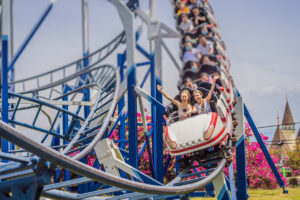 Amusement parks have replaced the beach as the place to go in the summer. Estimates are that nearly 200 million visits are paid to America’s 641 amusement parks annually, with the vast majority of those trips taking place in the summer months. The wide range of theme parks offer something for pretty much everyone, a virtual non-stop entertainment experience. But they can also be dangerous. Statistics gathered by the U.S. Consumer Product Safety Commission indicate that, on average, about 30,000 people seek treatment every year for injuries sustained at an amusement park.
Amusement parks have replaced the beach as the place to go in the summer. Estimates are that nearly 200 million visits are paid to America’s 641 amusement parks annually, with the vast majority of those trips taking place in the summer months. The wide range of theme parks offer something for pretty much everyone, a virtual non-stop entertainment experience. But they can also be dangerous. Statistics gathered by the U.S. Consumer Product Safety Commission indicate that, on average, about 30,000 people seek treatment every year for injuries sustained at an amusement park.
What Are the Most Common Accidents at Amusement Parks and What Are the Causes?
Amusement parks are mostly about the thrill—pushing yourself to the limit, experiencing the adrenaline when your brain and your body sense danger. Though many rides are carefully designed to maximize both exhilaration and safety, there are still many things that can go wrong. The most common injuries reported at amusement parks include:
- Head, neck, shoulder and back injuries, usually from violent changes of direction in a ride. Most common on roller coasters and spinning rides, they can be as serious as the whiplash-type injuries frequently suffered in motor vehicle accidents.
- Broken bones—These injuries occur primarily as a result of slips and falls, often at or near water-based rides, but also where there is loose flooring
- Cuts and bruises—Unprepared riders may suffer contusions when their bodies are thrown against a car in a ride. Some rides may have sharp corners that can cause lacerations.
- Connective tissue injuries—Many guests at amusement parks suffer sprains, strains or tears to muscles, ligaments, tendons and cartilage from the sudden and violent movements caused by certain rides
These injuries stem from a variety of issues:
- Design defects—Designing rides with poor or unstable center of gravity, making them likely to tip, failing to build reasonable safety measures into a ride
- Failure to maintain equipment—Maintenance takes time and costs money. As a consequence, many amusement park operators don’t adequately maintain the equipment.
- Mechanical failure—Occasionally, a ride will simply break down, often because of negligence or carelessness in the manufacture or assembly of the ride
- Operator error—The employees who operate the rides may lack training, experience or supervision, or may be careless in their work
What Can You Do to Minimize the Risk of Injury at an Amusement Park?
Though you can never guarantee your safety, there are steps you can take to minimize your risk of injury:
- Watch a ride a couple of times before letting your child on board—too many injuries occur because children become afraid and follow their instincts. Don’t put a small child in that position.
- Pay attention to (and follow) all posted restrictions for a ride—Take the time to listen for any special instructions before the ride starts
- Make certain all provided safety equipment is working and has been implemented before the ride begins
- Keep your hands and feet inside the car at all times—it may not be as much fun, but it’s a whole lot safer
- Resist the urge to pull your phone out—It’s not just the risk it poses to your safety. If a cell phone falls out of your hands on a fast-moving ride, it can strike another guest and cause serious injury.
- Protect yourself against sunburn!!—It may be the most commonly treated injury at amusement parks nationwide. You’re out having fun and you forget about the impact of the sun. Though it’s rare to get a third-degree burn from the sun, it’s possible. Second-degree burns can be extremely painful and may lead to permanent scarring or disfigurement.
Contact the Experienced Amusement Park Injury Lawyers at Bailey & Galyen
At the law offices of Bailey & Galyen, we bring more than 40 years of experience to people throughout Texas who have suffered any type of personal injury, including injuries suffered at an amusement or theme park. Since the inception of our firm, we have recovered hundreds of millions of dollars for injured people throughout the Lone Star State and across the nation. We will be your advocate throughout the legal process, from the investigation of your accident to the filing of a complaint through trial and the final resolution of your lawsuit. Contact us by e-mail or call our offices at one of the convenient locations listed below. Our phones are answered 24 hours a day, seven days a week.